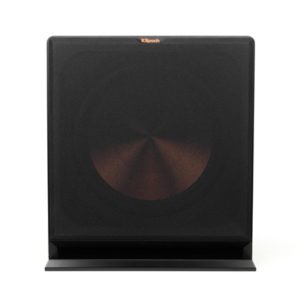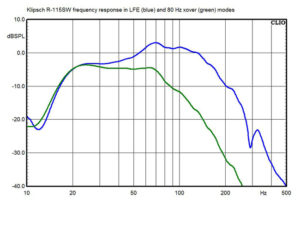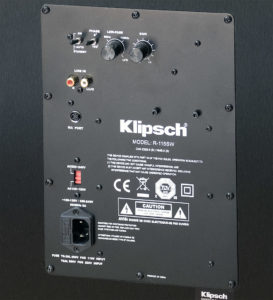HTR Product Rating for Klipsch R-115SW Subwoofer
Criteria Rating
Performance: 4.5 Stars
Value: 4 Stars
Overall: 4.5 Stars
The Klipsch R-115SW is one of the few subwoofers I’ve seen from a mainstream speaker company that’s built with the market realities of the Internet era in mind. It used to be, subwoofers were an afterthought for mainstream speaker companies. They could toss practically any old sub onto the market, safe in the knowledge that if someone bought Brand X speaker system, the dealer would probably talk them into adding a Brand X subwoofer.
Now there are fewer dealers, and more audio gear is purchased online. If online purchasers search around a bit, they’ll find subwoofer specialists such as Hsu Research, Power Sound Audio, and SVS whose subs often outperform those of the mainstream speaker companies yet usually cost less. And with the unforgiving CEA-2010 subwoofer output measurement being used by more manufacturers and reviewers, substandard subs have nowhere to hide.
At $899 USD, the R-115SW is priced to compete with the Internet-only companies. Technically, it’s standard stuff: a 15-inch Cerametallic (a proprietary mix of ceramic and aluminum) driver in a slot-ported box, powered by an 800-watt Class D amp. The only thing that’s even slightly unusual is the rear multipin port for Klipsch’s $129 WA-2 wireless connection kit. The sub looks really nice, with a brushed polymer veneer cabinet that mimics the look and feel of anodized aluminum.
It’s worth noting that I found the R-115SW available through several Internet outlets with free shipping. That’s a big deal; shipping on a sub this size can run more than $100.
The R-115SW can definitely compete in price. Let’s find out if it can compete in sound.
The Hookup
I started with the R-115SW in my listening room’s “subwoofer sweet spot,” the place I’ve found that most subs sound smoothest (against the wall under my projection screen, between my center and front right speakers). Note that this positioning prescription is particular to my room and my chosen seating position. You’ll have to find your own sub sweet spot.
I combined the R-115SW with two different speaker systems: my Revel Performa3 F206 tower speakers and a Klipsch Reference system based around the RP-280F towers. My stereo electronics included a Classé Audio CA-2300 amp and CP-800 preamp/DAC, using a Toshiba laptop as a digital music file source. For surround, I used a Denon AVR-2809Ci receiver connected to an AudioControl Savoy multichannel amp. In every case, I used a subwoofer crossover point of 80 Hz, so the sub would handle most of the bass on its own, without help from the tower speakers’ woofers. For comparisons with other subwoofers, I used my Audio by Van Alstine AVA ABX switchbox, which permits precise level-matching and quick switching.
Note that the R-115SW has only RCA line-level inputs, so it’s tough to use without something else providing a crossover between the main speakers and the sub. Of course, the Denon receiver has that, and fortunately so does the Classé CP-800, but it’s a rare feature in stereo preamps. If you do want to use this sub with a standard stereo preamp, you can run a couple of interconnect cables from the preamp to the sub, but that’s a rather clunky arrangement in my view. Or you can get the wireless kit.
As you’ll know if you read my review of the Sumiko S.9, I initially had some difficulty getting the R-115SW to blend well with the main speakers I used. As I suspected, I was finally able to get a better blend by experimenting with the phase switch and moving the sub around a couple of feet. Advanced subs like the Hsu VTF-15H Mk2 make this easier because you can tune the sound of the sub to some extent, and some subs–like the Sunfire XTEQ12 I’m currently testing–have auto EQ. If your receiver or pre/pro has some sort of auto EQ such as Audyssey, you may not care about tuning the sound and blend of your sub; you’ll probably just let the DSP chip do it for you.
Performance
I ended up doing most of my critical listening to the R-115SW in a system with the Klipsch RP-280F towers, partly because the system sounded really good and partly because I also needed to review the RP-280F and its associated center and surround speakers.
You might assume–and not without reason–that a sub with a 15-inch driver will sound boomy, slow, and sloppy. That’s not the case with the R-115SW. In fact, if I had to sum up its sound in one word, I’d say “tight.” In fact, I expected I’d do most of my listening to the R-115SW with movie soundtracks, but I spent the most time listening to jazz bassists, whose playing can turn into mush when fed through a mediocre subwoofer.
A great example can be heard on “Playground” from David Friesen’s Where the Light Falls. Friesen plays a Hemage bass, an unusual stand-mounted electric upright design that looks almost more like a club than a bass. I got to hear Friesen play it live a few weeks ago, and I was happy to hear that the R-115SW portrayed its unique tone–a big, resonant, almost bass-guitar-like bottom end with the singing, clear upper notes of a well-made, impeccably played upright. Friesen’s style seems to borrow from acoustic guitarists such as Ralph Towner and Michael Hedges, with all sorts of harmonics and strummed chords. It’s a tough sound to reproduce, especially in the lower range of the bass, because the bass was never designed for these techniques. But through the R-115SW, I could easily discern every note, which I couldn’t when I saw him live.
Pardon me for citing a similar example, but I can’t resist mentioning how great the Klipsch R-115SW (and the RP-280F towers) sounded when I played “Have You Met Miss Jones?” from the Oscar Peterson Trio’s We Get Requests. This recording of this tune might be the single greatest jazz bass performance ever. Most bassists would play a simple two-notes-the-bar feel through most of this tune, but bassist Ray Brown throws in all sorts of octave-plus leaps and fast-fingered melodic fills to answer Peterson’s melody. With the Klipsch setup, I could hear every note clearly and evenly–and I marveled at how perfectly even Brown’s level stayed no matter where he was playing on the instrument, or how fast. (I normally listen to this on headphones, most of which have a bass response that’s far from flat.)
That same tightness serves the R-115SW well on movie soundtracks, too. One of my favorite subwoofer tests is the opening of Star Wars, Episode II: Attack of the Clones, in which Senator Amidala’s silvery yacht passes overhead, producing high-decibel, low-frequency rumbles, then explodes right after landing. Playing the ship’s engine noise, the R-115SW pressurized my room almost like a real explosion would, providing a shaking sensation in the floor and in my chair that would have been frightening had I not tested so many monster subs. When the ship exploded, the R-115SW gave me a firm punch in the chest, yet it produced no audible distortion. “Tightness and punch are this sub’s thing,” I wrote in my listening notes.
This punchy character makes the R-115SW stand out a bit from most of the 15-inch subs I’ve tried. Some audio enthusiasts refer to this as “speed,” and it’s not something normally associated with such a large subwoofer–or a ported sub, for that matter.
Measurements
Frequency response
±3.0 dB from 18 to 152 Hz
Crossover low-pass roll-off
-20 dB/octave
Maximum output
CEA-2010A Traditional
(1M peak) (2M RMS)
40-63 Hz avg 123.2 dB 114.2 dB
63 Hz 123.3 dB L 114.3 dB L
50 Hz 124.7 dB L 115.7 dB L
40 Hz 121.4 dB L 112.4 dB L
20-31.5 Hz avg 114.6 dB 105.6 dB
31.5 Hz 118.6 dB L 109.6 dB L
25 Hz 113.8 dB 104.8 dB
20 Hz 108.7 dB 99.7 dB
The chart here shows the frequency response of the R-115SW with the crossover set to the maximum frequency, or LFE mode (blue trace) and to the 80-Hz position (green trace).
The only weird thing about the R-115SW’s frequency response is that big rise, peaking at 70 Hz. Note that it disappears when the crossover is engaged, and you get an almost perfectly flat response with a -3dB point at 80 Hz–exactly what you’re supposed to get. So, while the sub doesn’t measure flat without a crossover (which would never be the case), it should deliver a fairly flat response with one. If your receiver has an adjustable crossover slope, I’d recommend setting it to 3rd-order (-18dB/octave) response, which is closest to the response of the sub’s internal crossover.
The CEA-2010A results for the R-115SW are pretty impressive, in the neighborhood of what I’ve measured from some competing but typically larger subs. For example, the Hsu Research VTF-15H Mk2 delivers an average of 126.9 dB in the low bass (40-63 Hz) region and 119.9 dB in the ultra-low bass (20-31.5 Hz) range. My guess is you wouldn’t notice the Hsu’s +3.6dB improvement in the 40-63 Hz region because few people crank their system up loud enough to hear that. But if you’re really pushing the sub with ultra-low-frequency material, I would suspect from the measurement alone that the Hsu’s +5.3dB advantage from 20-31.5 Hz might make a significant difference. (As you can read in the review, my ears confirmed this.) Note that the R-115SW hits its limiter at every frequency from 31.5 to 63 Hz, which tells you the distortion will be relatively low at these frequencies. Maybe that’s why I got such a great sense of tightness and punch from this sub.
Here’s how I did the measurements. I measured frequency response using an Audiomatica Clio FW 10 audio analyzer with the MIC-01 measurement microphone. I did a ground-plane measurement with the microphone placed on the ground two meters from the sub, and the results smoothed to 1/6th octave.
I did CEA-2010A measurements using an Earthworks M30 measurement microphone, an M-Audio Mobile Pre USB interface and the CEA-2010 measurement software running on the Wavemetric Igor Pro scientific software package. I took these measurements at two meters peak output, then scaled them up to one-meter equivalent per CEA-2010A reporting requirements. The two sets of measurements I have presented here–CEA-2010A and traditional method–are functionally identical, but the traditional measurement employed by most audio websites and many manufacturers reports results at two-meter RMS equivalent, which is -9dB lower than CEA-2010A. An L next to the result indicates that the output was dictated by the subwoofer’s internal circuitry (i.e., limiter), and not by exceeding the CEA-2010A distortion thresholds. Averages are calculated in pascals.
The Downside
While the R-115SW offers impressive bottom-octave bass power, it can’t quite match the floor-shaking muscle of the most powerful 15-inch subs I’ve tested…although it does come pretty close. For example, the 16-Hz tones on the recording of the Saint-Säens Organ Symphony from the Boston Audio Society Test CD-1 didn’t shake my floor as much as they do with the Hsu VTF-15H Mk2 or the Power Sound Audio XV15se, although the R-115SW did reproduce the tones fairly cleanly. I also didn’t get as much ultra-deep rumble from the engines of the submarine and destroyer in chapter 14 (“Face to Face”) of U-571.
I also felt I was able to get just a touch more bass definition from the Sumiko S.9 and the Hsu VTF-15H Mk2. With the R-115SW, I heard all the notes clearly, but I didn’t get quite as much sense of “growl” from electric bass. That difference is subtle, though, and dependent on how well your sub blends with your speakers, which is in turn dependent on the crossover in your receiver or preamp/processor–and I’m probably hyper-sensitive to it because I play bass.
Comparison and Competition
The obvious competitors for the $899 R-115SW are the Hsu VTF-15H Mk 2 and the Power Sound Audio XV15se, both 15-inch subs in the same price range. The Hsu costs $1,008 including shipping; the Power Sound costs $899 with free shipping. Both of these competitors deliver a few dB more output than the R-115SW. I didn’t notice this difference at the higher frequencies, where the R-115SW seemed like it was trying to collapse my chest at times. However, as noted above, I did hear it in the lower frequencies below 40 Hz. But the Klipsch does have that appealing punch, possibly to a greater degree than the others.
The Hsu allows extensive tuning, with sealed, one-port, and two-port modes plus a Q knob that controls the resonance bandwidth (translation: tightness vs. looseness) of the sub. Neither the Klipsch nor the Power Sound model offers this, although of course an aftermarket EQ could be added to either.
Note that the Hsu VTF-15H Mk2 is 20 percent larger than the Klipsch R-115SW, but the R-115SW is eight percent larger than the Power Sound XV15se. The Klipsch is, in my opinion, nicer-looking than either competitor, but that’s not saying a lot.
Conclusion
I was starting to think that mainstream speaker companies had no business in today’s subwoofer business because they can’t deliver the kind of value and performance that some of the Internet-only guys can. The R-115SW proves that notion wrong. It’s competitive with practically any subwoofer on the market, yet it costs under $1,000. It does give up a little bit in power compared with its toughest competitors, but few home theater enthusiasts are likely to push their systems hard enough to discover this. And I think many audiophiles will be drawn to the R-115SW’s great sense of power and punch.
Read more at: https://hometheaterreview.com/klipsch-r-115sw-subwoofer-reviewed/
Where to buy Klipsch R-115SW: https://www.abtec.co.nz/product-search.php?keyword=Klipsch+R-115SW&category=&brand=&search=





